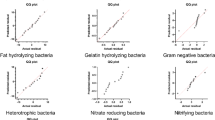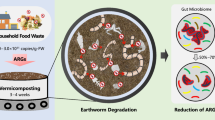Summary
A laboratory microcosm study was used to investigate the survival and population dynamics of genetically modified microorganisms (GMM) in the gut of Lumbricus terrestris. Three methods of axenic earthworm production were investigated. An antibiotic mixture of streptomycin and cycloheximide was introduced either passively, mixed with sterile soil or cellulose, or actively, by teflon catheter. Worms treated by all methods lost weight but this was least for the catheter method which was also the only method to produce axenic earthworms. Axenic earthworms were used to determine the effect of competition with indigenous gut bacteria on ingested GMM. The GMM used was Pseudomonas fluorescens, strain 10586/FAC510, with chromosomally inserted Lux genes for bioluminescence, and chromosomal resistance to rifampicin. The bacteria were grown up to the mid-exponential phase before inoculation into earthworms. Bacteria in faecal material were enumerated by dilution plate counting using selective agar. The GMM were re-isolated from the casts of both antibiotic-treated and untreated earthworms. Lower concentrations of GMM and higher concentrations of indigenous bacteria in the casts of untreated compared to antibiotic-treated earthworms suggested that competition is a fundamental control on population dynamics of the introduced bacterial inocula ingested by earthworms.
The catheter method, developed in this study, is proposed as a technique to contribute to the risk assessment of environmental release of GMM.
Similar content being viewed by others
References
Blakeman J, Fokkema NJ (1982) Potential for biological control of plant diseases on the phylloplane. Annu Rev Phytopathol 20:167–192
Bouché MB (1966) Sur un nouveau procede d'obtention de la vacuité artificielle du tube digestif des Lombricides. Rev Ecol Biol Sol 3:479–482
Bowen GD (1980) Misconceptions, concepts and approaches in rhizosphere biology. In: Ellwood DC, Hedger HN, Latham MJ, Lynch JM, Slater JH (eds) Contemporary microbial ecology. Academic Press, London, pp 283
Compeau G, Al-Achi BJ, Platsouka E, Levy SB (1988) Survival of rifampicin-resistant mutants of Pseudomonas fluorescens and Pseudomonas putida in soil systems. Appl Environ Microbiol 54: 2432–2438
Cook N, Silcock DJ, Waterhouse RN, Gray DI, Glover LA, Prosser JI (1992) Single cell detection of bioluminescent Pseudomonas syringae in soil. Proceedings of REGEM 2. Academic press, London (in press)
Daniel O, Anderson JM (1992) Microbial biomass and activity in contrasting soil materials after passage through the gut of the earthworm Lumbricus rubellus Hoffmeister. Soil Biol Biochem 24:465–477
Hand P, Hayes WA (1987) Production of axenic earthworms by antibiotic treatment. Soil Biol Biochem 19:475–477
Hamilton WE, Sillman DY (1989) Influence of earthworm middens on the distribution of soil microarthropods. Biol Fertil Soils 8:279–284
Henschke RB, Nucken E, Schmidt FRJ (1989) Fate and dispersal of recombinant bacteria in a soil microcosm containing the earthworm Lumbricus terrestris. Biol Fertil Soils 7:374–376
Ineson P, Anderson JM (1985) Aerobically isolated bacteria associated with the gut and faeces of the litter feeding macroarthropods Oniscus asellus and Glomerus spp. Soil Biol Biochem 17:843–849
Kristufek K, Pizl V, Szabo IM (1989) Composition of the intestinal streptomycete community of earthworms (Lumbricidae). Poecilotherms, Paris
Laverack MS (1963) Digestion and metabolism. In: Laverack MS (ed) The physiology of earthworms. Pergamon Press, London, pp 19
Lee KE (1985) Earthworms: Their ecology and relationship with soils and land use. Academic Press, London
Lindow SE (1983) Methods of preventing frost injury caused by epiphitic ice-nucleation-active bacteria. Plant Dis 67:327–333
Parle JN (1963a) Microorganisms in the intestine of earthworms. J Gen Microbiol 31:1–11
Parle JN (1963b) A microbial study of earthworm casts. J Gen Microbiol 31:13–22
Raw F (1962) Studies of earthworm populations in orchards: I. Leaf burial in apple orchards. Ann Appl Biol 50:389–404
Rouelle J (1983) Introduction of amoebae and Rhizobium japonicum into the gut of Eisenia fetida (Sav.) and Lumbricus terrestris. In: Satchell JE (ed) Earthworm ecology: From Darwin to vermiculture. Chapman and Hall, London New York, pp 375–381
Satchell JE (1967) Lumbricidae. In: Burgess A, Raw F (eds) Soil biology. Academic Press, London New York, pp 259–322
Satchell JE (1983) Earthworm microbiology. In: Satchell JE (ed) Earthworm ecology: From Darwin to vermiculture. Chapman and Hall, London New York, pp 351–364
Schippers B (1988) Biological control of pathogens with rhizobacteria. Phil Trans R Soc London 318:283–293
Sims RW, Gerard BE (1985) Earthworms, Synopsis of the British Fauna, 31. Brill and Backhuys (Linn Soc), London
Vimmerstedt JP (1983) Earthworm ecology in reclaimed opencast coal mining sites in Ohio. In: Satchell JE (ed) Earthworm ecology: From Darwin to vermiculture. Chapman and Hall, London New York, pp 229–240
Whiston RA, Seal KJ (1988) Rapid production of axenic specimens of the earthworm Eisenia foetida using microcrystalline cellulose as a carrier medium for antibiotics. Soil Biol Biochem 20:407–408
Author information
Authors and Affiliations
Rights and permissions
About this article
Cite this article
Thorpe, I.S., Killham, K., Prosser, J.I. et al. Novel method for the study of the population dynamics of a genetically modified microorganism in the gut of the earthworm Lumbricus terrestris . Biol Fertil Soils 15, 55–59 (1993). https://doi.org/10.1007/BF00336289
Received:
Issue Date:
DOI: https://doi.org/10.1007/BF00336289




